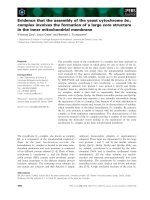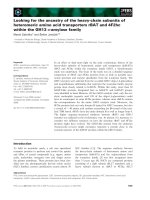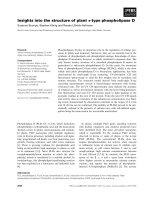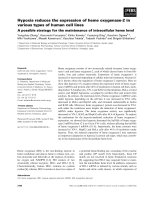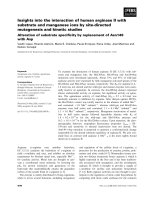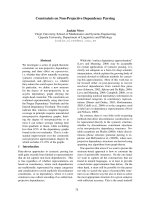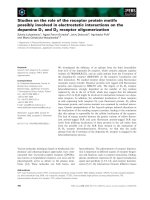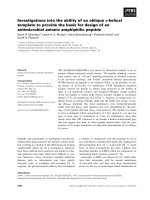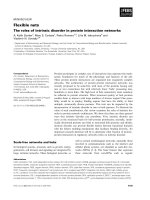Báo cáo khoa học: "CONSTRAINTS ON THE GENERATION OF ADJUNCT CLAUSES" potx
Bạn đang xem bản rút gọn của tài liệu. Xem và tải ngay bản đầy đủ của tài liệu tại đây (682.97 KB, 8 trang )
CONSTRAINTS ON THE GENERATION OF ADJUNCT CLAUSES
Alison K. Huettner* Marie M. Vaughan ** David D. McDonald **
Department of Linguistics *
Department of Computer & Information Science **
University of Massacusettts
Amherst, Massachusetts 01003
ABSTRACT
This paper presents an analysis of a family of
particular English constructions, all of which roughly
express "purpose". In particular we look at the
purpose clause, rationale .clause, and infinitival
relative clause. We (1) show that couching the
analysis in a computational framework, specifically
generation, provides a more satisfying account than
analyses based strictly on descriptive linguistics, (2)
describe an implementation of our analysis in the
natural language generation system MUMBLE-86, and
(3) discuss how our architecture improves upon the
techniques used by other generation systems for
handling these and other adjunct constructions.
1. INTRODUCTION
Natural language provides a variety of devices for
expressing relations between elements in a text
Simply positioning two sentences in sequence conveys
an implicit relation between them:
(1)
I bought a book. I'm going to read it on the plane.
Clauses may also be joined with explicit lexical
connectives:
(2)
I bought a book so that I could read it on the plane.
A few relations may be expressed directly through
particular types of subordination of one clause to
another1:
(3)
I bought a book to read on the plane.
This latter category is the most cohesive of these
three devices, as the adjunct is crucially dependent on
the material in the matrix clause for its interpretation
(Halliday & Hasan, 1976). However, such structural
linking mechanisms are also the most limited in
applicability: only certain relations may be expressed
1 We refer here to infinitive clauses which are grammatically
related to the main clause as optional adverbials rather than as
complements (arguments) to a verb, such as
"Floyd wanted to
go to the zoo".
in this way and complex grammatical constraints must
be satisfied.
In this paper, we analyze a particular class of
structural devices, including the purpose clause
(exemplified in 3 above), rationale clause, and
infinitival relative, from the perspective of natural
language generation. All three constructions express
kinds of "purpose": purpose clauses express the use to
which someone will put an object that is expressed in
the main clause; rationale clauses express the overall
intention behind the main clause action; infinitival
relatives express the usual function of their NP head.2
We look at what underlying semantic relations license
the constructions, the constraints on the syntactic
form of the main and adjunct clauses, and the gapping
pattern of the arguments of each adjunct. We discuss
these as information needed by the generator in order
for it to choose
and use
these devices correctly and
discuss at what stages in the generation process the
information must be applied.
We contrast our analysis with those typically
given from the perspective of generative-
transformational linguistics, particularly thematic
analyses, concluding that an analysis that considers the
construction in a particular situation and in terms of a
coherent model of the world can capture the
constraints more easily. We provide a particular
example implemented in the natural language
generation system MUMBLE-86 (McDonald, 1984)
and show how our analysis may be generalized to
similar structural adjunct constructions. We further
show that many earlier approaches to generating
complex sentences (Derr & McKeown, 1984; Davey,
1974; Kukich, 1985; Mann & Moore, 1981) have
architectural limitations that would keep them from
handling these types of constructions with any
generality.
2 The notion of "purpose" is of course ambiguous between
"intention"
and "function".
207
2. DESCRIPTION OF THE CONSTRUCTION
Before addressing the generation of adjunct
infinitive clauses, it is necessary to define our terms
and distinguish the different constructions. We will
begin by discussing purpose clauses 3 and then contrast
them with rationale and infinitival relative clauses.
2.1 Purpose clauses
A purpose clause (PC) expresses the purpose or
intended use of a particular object which the main
clause is in some sense "about". It is attached as
a
daughter of VP and is fixed in VP final position. It
has the following variants, distinguished trivially by
the position of the gap: 4
(4)
a. I bought the shelfi [e i to hold my cookbooks]
b. I bought the cookies i [for Mary to eat ei]
e. I bought the cushion i [for Mary to sit on eL1
The sentences in (4) demonstrate that PC has one
obligatory gap, which can occur in any of its NP
argument positions: subject position, as in (a);5 direct
object position, as in (b); or prepositional object
position, as in (c). The gap is coreferential with
CcontroIled by") the direct object of an SVO main
clause, or with the subject of a passive or unaccusative
main clause. This pattern of antecedents has been
variously characterized as deep structure (direct)
objects (Huettner, 1987; implicitly in Rappaport &
Levin, 1986); as arguments bearing the thematic role
of Theme (Faraci, 1974; Williams, 1980); or as
entities whose availability for further manipulation
plays a part in the semantics of the sentence (Jones,
1985).
A PC with its obligatory gap in non-subject
position (like those in 4b,c above) may have an
additional subject gap, as shown in (5):
(5)
lj bought it i [ej to eat ei]
This second gap is optional, and the determination
of its antecedent is more complex than the controller
of the obligatory gap. In (5) the PC subject is
coindexed with the matrix (main clause) subject;
however, (6) shows that an indirect object takes
3 The purpose clause has also been known as a "re~oactive
purpose clause", for example in Jespersen (1940). Jespersen
reserves the term "purpose clause" for what we are calling a
rationale clause; however, our terminology dates at least from
Faraci (1974) and is used by Bach (1982) and Jones (1985)
among others.
4 The symbol "e" stands for an empty category, or gap, in an
argument position. The subscripts indicate coreference.
5 A PC with a subject gap is often called an objective clause.
precedence over the subject as controller for tnls
gap: 6
(6)
a. I gave it i to Mary k [e k to read ell
b. *lj gave it i to Mary k [ej to read ei]
When there is no suitable antecedent in the matrix,
the optional subject gap will have arbitrary or
indefinite reference:
(7) a.
This box i was purchased [ear b to keep supplies in ell
b. These doughnuts i are [ear b to eat ell
The set of antecedents for the optional subject gap
has been characterized configurationally, as the
"closest" NP argument after the obligatory gap has
found an antecedent (Chomsky, 1980) ; thematically,
as the highest NP argument on a "thematic hierarchy"
ranging from Goal to "arbitrary" (Nishigauchi,
1984); and pragmatically, as the person in whose
control the Theme is at the time of the action
(Ladusaw & Dowty, 1985).
2.2 Rationale Clause
Easily confused with the purpose clause is the
rationale clause (RatC), also known as an "in order
to" clause or result clause. RatC can be distinguished
from PC by the fact that RatC permit only subject
gaps, whose antecedent is (usually) the matrix
subject, rather than its object. Note the ambiguity of
the following:
(8)
Amy Lou i took Mildredj to the zoo ei/j to feed the lions.
On the PC reading, Mildred is feeding the lions;
on the RatC reading Amy Lou is feeding the lions
(possibly using Mildred as lion food). A RatC
reading may always be paraphrased with
in order,
as
in (9), to rule out the PC reading:
(9)
Amy Lou i took Mildredj to the zoo in order el~. j to feed
the lions.
In contrast with PC, the controller of a RatC gap
need not be any argument of the main verb, but can be
the matrix predicate as a whole:
(10)
Mildred was thrown in the lion cage to keep her from
talldng.
6 Notice that in sentences like (6a), it is the status of
Mary
as
indirect object which allows it to control the subject gap.
Prepositional objects which are not indirect objects cannot be
controllers here, as shown in (a) below, while indirect objects
which are not prepositional objects may still control the PC
subject ((b) below).
a. Ij got the bonesifrom Paul k [ej/*k to feed e i to the dog]
b. lj gave Mary k this very dull book i [e*j/k to read ei]
208
Further, the RatC subject gap is optional:
(i 1)
Elroy killed Oscar in order for Sylvia to escape.
Finally, RatC are daughters of S, and not VP, and
may therefore be preposed alone (12b) or otherwise
isolated from the VP (12c):
(12) a.
Helga carries a hat pin to protect herself.
b.To protect herself, Helga carries a hat pin.
c.What Helga does to protect herself is carry a hat pin.
2.3 Infinitival Relative
Clauses
Infinitival Relatives (IR) are superficially very
similar to purpose clauses, especially in the patterning
of their gaps. Like tensed relatives, they are
daughters of NP; if the NP in question is in the VP,
IR can be easily mistaken for PC:
(13)
a. IR: I bought [ a pan i [e to fry omelets in ei] ]
b. PC: 1 bought [ apart i ] [e to fry omelets in e i
(14) a. IR:
Elroy really needs [ a woman i [ e i to hoM his
hana l l
b. PC: Elroy really needs [ a woman i ] [ e i to hold his
hand l
IR, like PC, have one obligatory gap in either
object (13a) or subject (14a) position, which is
controlled, not by the matrix object (as in PC), but by
the head of the NP containing the relative (just as in a
tensed relative clause). If the obligatory gap is in
object position, there may or not be a subject gap as
well. This optional subject gap is controlled exactly
like the optional gap in a PC.
An IR may be distinguished from a PC by making
its containing NP the subject of the matrix sentence;
PC may not occur in post-subject position. Another
test is to make pro-nominal or definite the antecedent
of the obligatory gap; IR may only have indefinite
heads.
2.4 What the constructions mean
Three things are being communicated when one
uses a purpose clause: an event of acquisition or use,
an object (the thing which is being acquired or used),
and the purpose to which the object will be put. That
these elements form a deliberate complex and are not
independent is made clear by attempting to omit
either of the first two elements while retaining the
syntactic form that gives the purpose clause its special
character. In (15a), the object is not explicit in the
matrix clause; in (15b), the matrix does not convey
any sense of possession. Both are ungrammatical.
(15)
a. *I went to the bookstore to read on the plane.
b. *Peter read a book for Helga to read on the plane.
The infinitival relative, in contrast, has only two
elements: an object and its purpose. Furthermore,
there is no particular event that this purpose is
specific to, i.e. no special relationship between the
matrix clause in which the object appears and the
purpose expressed by the relative. 7 Consequently, the
notion of purpose in an IR is narrower than in a PC,
closer to the object's intrinsic function or unmarked
use.
The rationale clause differs from both the PC and
IR by not being object centered at all. Instead, a RatC
adjunct expresses the goal which the matrix action
was intended to bring about.
Note that as the various types of infinitive clauses
become less deeply embedded, syntactically speaking,
the scope of the expressed purpose becomes wider:
from the standard function of an object, expressed
within a noun phrase (IR); to the function some agent
has imposed on an object, expressed in the verb
phrase (PC); to the intended goal of the agent in
performing the matrix activity, expressed in an S-
level adjunct (RatC).
3. GENERATING THE CONSTRUCTIONS
To analyse a construction for generation, we must
consider what it means, or, put another way, consider
why a speaker would choose to use it, especially given
the subtleties of meaning that differentiate it from
similar constructions. The next consideration, and
the subject of the present section, is how the
construction should be situated within the generation
process: what decisions, made at what point or points
in the process, contribute to the selection and
realization of the construction as part of an utterance?
We begin with an overview of how decision making is
organized in our model of generation. We then look
at how a descriptive treatment in terms of thematic
roles could be turned into an algorithm for
generation, and show that it fails to take advantage of
the information that is available at the early stages of
generation. A treatment tailored to generation is
markedly simpler: creating a PC from a motivated
message is easier than describing the end product.
7 An NP containing an infinitival relative clause is
characteristically descriptive rather than referential; however,
this has more to do with the restrictive nature of the relative than
with the content of the matrix.
209
3.1 Decision Making in Generation
In generation, unlike comprehension, the
speaker's appreciation of his situation, his goals, and
the information that he wants to communicate are
self-evident, rather than needing to be discovered.
The core problem in generation is making decisions:
knowing what decisions must be made, what
information bears on them, what the alternative
choices are and how they are to be represented.
Carefully controlling the timing of when specific
decisions are made offers the possibility of designing
the generation process so as to achieve a very high
level of efficiency. Forcing a decision too early
before all of the information it requires is available
may lead to guessing and later having to back up and
undo that choice and any later ones that depended on
it. Making a decision too late can mean missing
opportunities to propagate information about the
choice to other decisions that it should influence.
Overall, the most pivotal and least constrained
decisions should be made first, so that their
consequences can be known soon enough to not hold
up the others that are dependent on their choices.
In our model of generation, this criterion has led
us to the view that decisions about the information an
utterance is to convey will be made before decisions
about syntactic form or serial order. These early
decisions typically include choices of wording and
influence all aspects of a text's form. The output of.
such decisions is expressed in an explicit
representational level we call the "message level"
(McDonald & Vaughan, 1987). Decisions reflecting
the surface ordering of the arguments are made in the
mapping to the next level of representation, the
surface structure. As this structure is traversed,
decisions about the particular realization of the
arguments are made, morphological specialization is
done, and the text is output.
3.2 Attempting to Adapt a Descriptive
Analysis
In conventional transformational=generative
analyses, the rules governing the occurrence of gaps
in the constructions we are studying are characterized
from a purely descriptive perspective. They do not
try to determine which argument should be gapped,
but rather where gaps may occur and what the
antecedent of each gap will be. Directly adapting such
an analysis to the generation task would involve
complete specification of the surface structure
followed by a multi-step matching algorithm to
realize the gap(s).
Of descriptive analyses, those couched in terms of
thematic roles seem best suited for the generation of
PC, since they allow a single description of the
antecedent of the obligatory gap. A possible
algorithm for locating gaps in PC would be as follows
(assuming that arguments of the matrix verb are still
accessible from within the adjunct and are annotated
with their thematic roles):
.
.
Gap the first argument in the PC which is an
occurrence of the matrix Theme.
a. If the PC subject matches the matrix Goal,
gap it; or
b. if there is no matrix Goal and the PC subject
matches the matrix Source or Location, gap
it; or
c. if there is no matrix Source or Location
either, and the PC subject is given as
"unspecified", gap it.
While for our purposes such an algorithm is an
im-provement over a structural description, it is still
unnecessarily complicated. For instance, there is no
need to search the matrix clause for its theme since
when generating we already know trivially which
argument to obligatorily gap the one that the
purpose clause was chosen to express the purpose of.
3.3 Choosing the construction
Since, as we have discussed, there are semantic
differences among PC, IR and RatC, the choice
among them is more than just stylistically motivated
syntactic variation. This means that they will be
distinguished at the message level, since that is where
an utterance's information content is determined. We
have also argued that the PC and its matrix clause
form a conceptual unit centering around the object
whose use is in question. If that integrity is not to be
left to chance, that conceptual unit must be chosen as
a piece, making the PC an atomic resource that the
English language provides, like adjectives or the
copular clause.
At the message level then, we have a three part
relation embodied in a "realization specification" (see
example in Section Four), which stipulates that the
statement of possession or access to an object and the
statement of the purpose of that object are to be
realized as main clause and PC respectively, with the
occurrence of the object in the PC realized as a trace.
The obligatory gap is thus inserted at the message
level, and persists into surface structure, where
realization of the two clauses as active, passive, etc.
can take place without a subsequent costly calculation
210
of which structural position should be realized as a
gap. (We will discuss the optional gap below). Since
the tense of the adjunct is left unspecified in the
realization specification, it will surface as an
infinitive.
Delaying the realization of the two clauses until
the linguistic context governing that realiation has
been established provides versatility. For example,
the whole construction could be a complement to
another verb, as in (16a), or to another infinitival
adjunct, such as the rationale clause shown in (16b):
(16)
a. I wanted to buy a book to read on the plane.
b. I went to the bookstore to buy a book to read on the
plane.
One potential problem with this analysis is that the
lack of prior constraint leaves open the possibility of
generating rather awkward constructions, such as the
following:
(17)
A book was bought by me to read on the plane.
It is our intuition, however, that the awkwardness
of this sentence comes from a lack of motivation for
the passive rather than any problem with the
construction as a whole. Without a motivated source,
this construction would never be generated;
consequently we need not address how to block it. We
can use this sort of argument to great advantage when
working in a generation framework, which is one of
the reasons why it provides a better model of how
language is actually produced than the usual linguistic
strategy of free generation with surface level filters.
The obligatory gap in the PC can (and should) be
handled at the message level because (1) at that point
all the information it requires is available, (2) no
further information bearing on the identification of
the argument to be gapped will become available later
during realization (i.e. there is nothing gained by
waiting), and (3) the means for carrying out the
gapping operation are at hand (see next section). The
optional subject gap is a different matter. This gap is
licensed only if its antecedent is explicitly mentioned
in the main clause, a fact that is not known at the
message level. (More to the point, having known the
information when the message was being assembled
was unlikely to have changed the decisions that were
made; consequently there is no utility to making it
explicit there.)
Since the information needed to consider gapping
the PC's subject is not available until the matrix clause
has been realized, the gapping operation must be done
at the level of surface structure rather than the
message level. By relying on the fact that only well-
formed, motivated messages are ever going to be
constructed, a surface-level rule for the operation can
be compactly stated: "gap if the subject is mentioned
in the matrix or is arbitrary (and non-emphatic). ''8
The single gap of a rationale clause is handled
very much like the optional gap of the purpose clause.
The planner is responsible for the overall relationship
between an action and an intended result of that
action. When the message is converted to a surface
structure, it is realized as a main and a subordinate
clause; the main clause, as the head of the bundle, is
built first, and the RatC is then attached either before
or after it. During traversal of the tree, the RatC
subject will be gapped if it matches the main clause
subject or the main clause as a whole. Once again, the
information needed to determine whether to gap is
not available until late in the process.
4. EXAMPLE
In this section we describe the particulars of our
implementation of purpose clauses in the natural
language generation system, Mumble. As we
discussed in the previous section, this construction
originates from a three part relation between an
event, an object, and its purpose. At the message
level, the interface to Mumble, the schema shown
below in Figure One takes these three arguments and
builds a realization specification for a purpose clause:
define-specification-schema
object-centered-event-&-purpose
(object event object-purpose)
(let ((matrix (instantiate-specification
event))
(adjunct (instantiate-specification
object-purpose)))
(add-further-specification matrix
:specification adjunct
:attachment-function 'purpose-of)
(locate-argument-&-force-to-a-trace
object :containing-rspec adjunct) ))
FIGURE ONE
8 "Emphatic" refers to both marked stress, as in (a), or an
unusual situation, as in (b), where the possessor is not the
intended user:
a. I bought that dinosaur for me tO
play with (so keep
your
off it: )
b. I bought David a dinosaur for rne to play with (when 1 go
over to his house).
In a generation model, which assumes the generator is working
in the service of some coherent underlying program, the
information of when something is emphatic, or marked, is
always know and can be made available to the linguistic
processes, and would be necessary in any event in order to
generate speech.
211
Figure Two shows the pretty printing of the
realization specification created by this schema in
order to generate the following text:
"Floyd bought Helga a book
m
read on the plane."
(event-bundle
:head ( : realization-fn buy
I : arguments (#<Floyd> #<Helga>
#<book> ) )
~:accessories ( tense-modal past )
: further-specifications
( ( : specification
(event-bundle
:head ( : realization-fn read
: arguments
( #<Helga>
(:trace #<book>)) )
: further-specifications
(#<on-location #<read >
#<plane> > )
5- :attachment-fn purpose-of ) ) )
FIGURE TWO
In order to make the example clearer, we have
used the" short hand notation #< > to indicate an
underlying object from which a specification will be
planned, rather than writing out its specification in all
its detail. In the context of an actual underlying
program generating from internally modeled objects,
these could be unplanned specifications of objects,
with planning and realization interleaved. However,
as this example presently runs in our "stand-alone"
interface, all the details are spelled out in the
realization specification.
The bundle representation allows the planner to
group component parts of the utterance. The head of
the bundle (#1) is a constraint expression specifying
the matrix clause. Accessories (#2) contain
linguistically marked information, such as tense and
NP number. The further-specification field (#3)
specifies the adjunct. Note that the argument for
#<book> (#4) has already been constrained to be a
trace. The attachment function (#5) indicates how the
further specification is related to the head. In this
instance the attachment function is the particular
attachment point PURPOSE-OF (shown in Figure
Three), which splices a new element, labeled FOR-
INFINITIVE, into the surface structure as the last
element of the VP.
(define-attachment-point purpose-of
:splice
:reference-labels (vp)
:link (last)
:new-slot (for-infinitive) )
FIGURE THREE
Every specification has a realization function and
a list of arguments. In general, the realization
function is a class of choices which defines the set of
initial trees (Joshi, 1985) which can realize the
specification. The choices are annotated with the
grammatical and contextual characteristics which
distinguish their use. For example READ (#6),
through a curried realization class (shown in Figure
Four), uses the class AGENT-VERB-THEME 9
(define-curried-realization-class Read
(agent theme)
: class agent-verb-theme
((verb "read") ))
(define-realization~class Agent-verb-theme
(agent verb theme)
( ((basic-clause-svo agent verb theme)
(clause) () )
((for-infinitive-svo agent verb theme)
(for-infinitive) () )
( (relative-clause-svo rel-pro (agent)
trace (agent)
verb
theme) )
(relative-clause)
(arg-same-as-head(agent)) )
((relative-clause-svo tel-pro(theme)
agent
verb
trace(theme)) )
(relative-clause)
(arg-same-as-head(theme)) )
))
FIGURE FOUR
The message is realized in stages. First, the head
of the bundle (#1) is realized by making a choice in its
class (similar to that for READ in Figure Four) and
building the surface structure representation for that
choice, shown below in Figure Five.
[SENTENCE]
clause
~
attachment-point
[SUBJECT] ~-[PREDICATEI
purpose-o!
#,: FLOYD /
vp ~
[VERB] ~ [INDIR-OBJI ._t~[DIR -OBJ]
"buy" #,: HELGA ~, #,~ BOOK .~
FIGURE FIVE
9 We use thematic roles as argument names in classes
heuristically; we are not committing ourselves at this point to a
thematic analysis of argument structure.
212
The accessories (#2) are then processed, which in
this example sets the tense. Next the further
specification is spliced in using the indicated
attachment point. The surface structure is traversed,
and embedded arguments are realized as they are
reached. The result of these operations and the
traversal up to the subject of the adjunct is shown in
Figure Six. Note that the text of the main clause has
been morphologically specialized and output as a side
effect of the traversal, the surface structure for the
argument NPs has been chosen and built, and the trace
for the obligatory gap is already in place.
At this point the optional subject gap of the
adjunct is considered. Since "Helga" is available as an
explicit argument of the matrix clause, the subject is
realized as a trace and the "for" is supressed.
5. RELATED WORK IN GENERATION
Derr & McKeown (1984) directly address the
generation of complex sentences; however, they
restrict the criteria for combining propositions to
focus and shared arguments. While it is fairly clear
that they could extend their analysis to allow
combinations based on relations between propositions
that are expressible as explicit lexical connectives, it is
unclear as to whether they could as easily extend it to
relations expressed structurally: They assume that the
propositions are independently determined before
possibilities for combinations are considered. While
a special device could determine whether the
particular relation licensing a PC was intended, they
would lose the advantage we gain from letting the
initial choice of object and construction be made
simultaneously. They would have to use an algorithm
such as the one described in the thematic analysis
above to determine the gapping pattern of the adjunct.
Davey (1974) and Kukich (1985) both simplify
their approach to the problem by completely
predetermining how propositions may be combined
into complex sentences. Kukich uses predefined
phrases and Davey a set of rules particular to the
annotated move list of the tic-tac-toe game he is
generating from. While these approaches provide an
opportunity for choosing structures such as purpose
clauses early and as one piece, they are seriously
lacking in generality and flexibility. Both assume a
limited domain where all of the possible propositions
and their plausible combinations can be
predetermined.
In the Knowledge Delivery System (KDS) Mann
& Moore (1981) use a hillclimbing algorithm to
determine which propositions should be combined
into complex sentences. The algorithm assumes the
information to be conveyed has been broken into
kernel sized chunks and filtered to delete any
repetitious or inferable information. This has the
drawback that once the original information has been
fragmented into kernels, the original relations
between them have been lost. The aggregation rules
must consequently use shared arguments and
predefined templates to combine the kernels into
sentence sized chunks. This causes the same problems
as those described for Derr & McKeown:
determining the gapping pattern in the adjunct clause
and retaining generality.
[SENTENCE]
clause
[SUBJECTI 4~ [TNS] ~ [PREDICATE]
<past>
np
S V P ~.,~ ,~ ,., ~
[HEAD] [VERBI ~INDIR-OBJ] ~ [DIR -OBJ]
"Floyd"
np
b-, j
[HEADI
"Helga"
Text output
so far:
Floyd bought Helga a book
[FOR-INFINITIVE]
np clause
[HEAD]
"book"
[FOR-SUBJECT] "= I~[PREDICATEI
[VERB] .__.~[DIR -OBJt . . .
"head" trace
FIGURE SIX
213
6. CONCLUSION
In this paper we have shown the importance of
carefully choosing the framework in which to couch
one's analysis. For the generation of adjunct clauses,
a computational approach which assumes a coherent
underlying world model and text planner has clear
advantages over a descriptive representation. We
have also shown advantages of our model of
generation: Our use of a message level distinct from
and prior to the surface structure representation
allows decisions to be made when germane
information is most naturally available.
7. REFERENCES
Bach, Emmon (1982), "Purpose Clauses and Control." In
Jacobson & Pullum, eds., The Nature of Syntactic
Representation, Reidel, Dordreeht, pp. 35-57.
Chomsky, Noam (1980), "On Binding." Linguistic Inquiry
11.1, MIT Press, Cambridge.
Davey, Anthony (1974), Discourse Production. Edinburgh
University Press, Edinburgh, U.K. "Using Focus to
Generate Complex and Simple Sentences." Proceedings of
Coling-84, pp.319-326.
Faraci, Robert A. (1974), Aspects of the Grammar of
Infinitives and For Phrases. MIT Doctoral Dissertation
(unpublished).
Halliday, M.A.K. & Ruqaiya Hasan (1976), Cohesion in
English London: Longman Group Ltd.
Huettner, Alison K. (1987), Adjunct Infinitives: An Exegesis.
PhD Dissertation, University of Massachusetts, Amherst,
Massachusetts, forthcoming.
Jespersen, Otto (1940), A Modern English Grammar on
Historical Principles. G. Allen & Unwin, London.
Jones, Charles (1985), Syntax and Thematics of Infinitival
Adjuncts. Phi3 Dissertation, University of Massachusetts,
Amherst, Massauchusetts.
Joshi, Aravind (1985), "Tree Adjoining Grammars: How
much context-sensitivity is required to provide reasonable
structural descriptions?" In Dowty, Karttunen, & Zwicky
(eds.), Natural Language Parsing, Cambridge University
Press, Cambridge.
Kukich, Karen (1985), "Explanation Structures in XSEL."
Proceedings of the 23rd Annual Meeting of the Association
for Computational Linguistics, pp. 228-237.
Ladusaw, William & David Dowry (i985), "Towards a Formal
Semantic Account of Thematic Roles." Unpublished
manuscript.
Mann, William & James Moore (1981), "Computer Generation
of Multi-paragraph English Text." American Journal of
Computational Linguistics, Vol. 7, No.l, Jan Mar.,
pp. 17-29.
McDonald David D. (1984), "Description Directed Control: Its
implications for natural language generation." In Cercone
(ed.), Computational Linguistics, Plenum Press, pp. 403-
424; reprinted in Grosz, Sparck Jones, & Webber,
Readings in Natural Language Processing, Morgan
Kaufman Publishers, California, 1986.
McDonald David D. & Marie M. Vaughan (1987), "Arguments
for a Message Level in Natural Language Generation."
Submitted to UCAI-87.
Nishigauchi, Taisuke (I984), "Control and the Thematic
Domain." Language 60, Linguistic Society of America,
Waverly Press, Baltimore.
Rappaport, Malka & Beth Levin (1986), "What to do with
Theta Roles." Lexicon Project Working Papers #11, MIT
Center for Cognitive Science, Cambridge.
Ritehie, Graeme (1984), "A Rational Reconstruction of the
Proteus Sentence Planner." Proceedings of Coling-84, pp.
327-329.
Williams, Edwin (1980), "Predication." Linguistic Inquiry
11.1, MIT Press, Cambridge.
214
